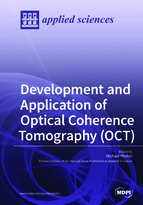Development and Application of Optical Coherence Tomography (OCT)
A special issue of Applied Sciences (ISSN 2076-3417). This special issue belongs to the section "Optics and Lasers".
Deadline for manuscript submissions: closed (20 January 2017) | Viewed by 99463
Special Issue Editor
Interests: optical coherence tomography; adaptive optics; polarization sensitive imaging; functional imaging
Special Issues, Collections and Topics in MDPI journals
Special Issue Information
Dear Colleagues,
Optical coherence tomography (OCT) is a powerful non-invasive optical imaging technique that provides cross sectional images of turbid and translucent samples with high axial resolution. In this year, 2016, the technology celebrates its 25th anniversary. Since the beginning of OCT, the technology has evolved rapidly. Thereby, the imaging speed has been increased from roughly one depth scan (A-scan) to several millions of A-scans per second. This development paved the way for new applications. The main field of application can be found in the field of ophthalmology where OCT is meanwhile regarded as routine diagnostic tool. Other applications include cardiovascular research, dermatology, small animal imaging, material sciences and many more. In addition, many extensions of the technique such as Doppler OCT, polarization sensitive OCT, OCT angiography, OCT elastography, and coherence microscopy, just to name a few, have been introduced. Current research focuses on these extensions, as well as on the combination with other imaging modalities.
This Special Issue of the journal Applied Sciences, “Development and Application of Optical Coherence Tomography (OCT)” is dedicated to cover some of the recent aspects in the development, as well as in the application, of OCT.
Prof. Dr. Michael Pircher
Guest Editor
Manuscript Submission Information
Manuscripts should be submitted online at www.mdpi.com by registering and logging in to this website. Once you are registered, click here to go to the submission form. Manuscripts can be submitted until the deadline. All submissions that pass pre-check are peer-reviewed. Accepted papers will be published continuously in the journal (as soon as accepted) and will be listed together on the special issue website. Research articles, review articles as well as short communications are invited. For planned papers, a title and short abstract (about 100 words) can be sent to the Editorial Office for announcement on this website.
Submitted manuscripts should not have been published previously, nor be under consideration for publication elsewhere (except conference proceedings papers). All manuscripts are thoroughly refereed through a single-blind peer-review process. A guide for authors and other relevant information for submission of manuscripts is available on the Instructions for Authors page. Applied Sciences is an international peer-reviewed open access semimonthly journal published by MDPI.
Please visit the Instructions for Authors page before submitting a manuscript. The Article Processing Charge (APC) for publication in this open access journal is 2400 CHF (Swiss Francs). Submitted papers should be well formatted and use good English. Authors may use MDPI's English editing service prior to publication or during author revisions.
Keywords
- Optical coherence tomography
- Optical coherence angiography
- Optical coherence microscopy
- Polarization sensitive OCT
- Doppler OCT
- Adaptive optics
- Dermatology
- Ophthalmic imaging
- Non destructive testing






